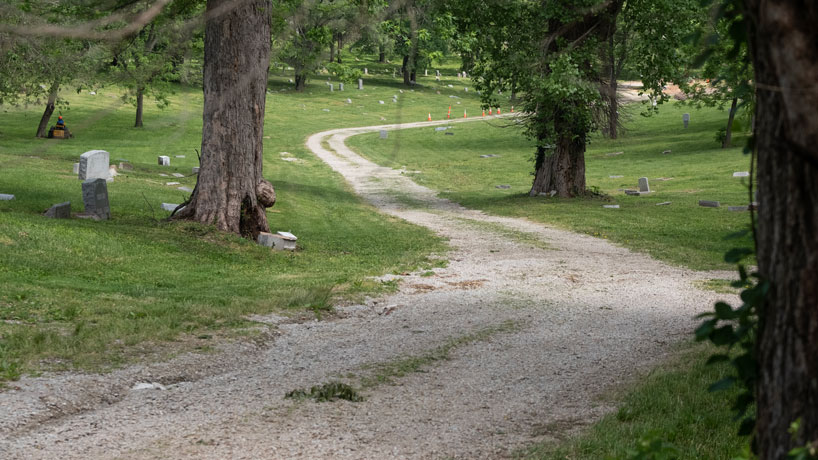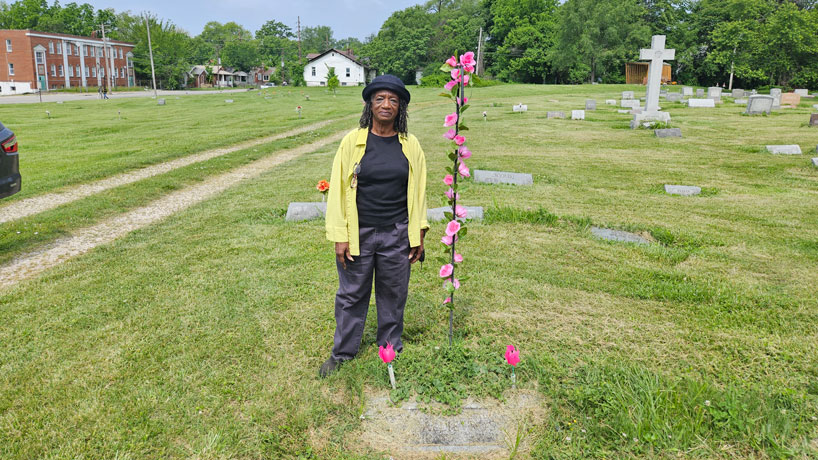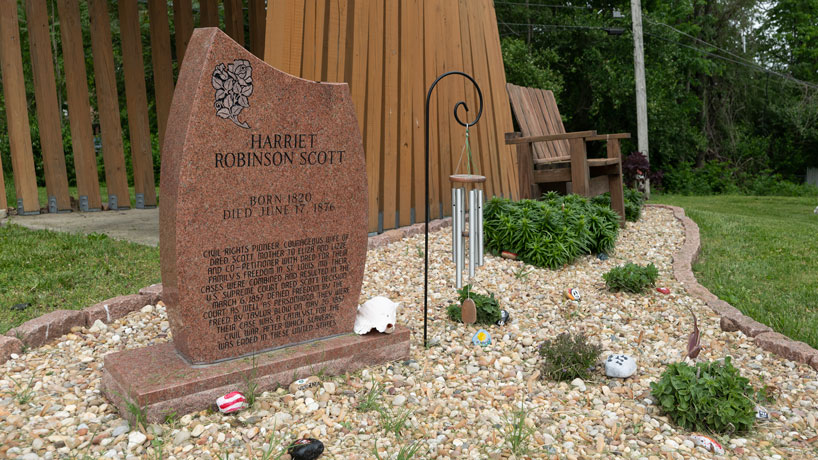
Historic Greenwood Cemetery is getting help from Gary Moore, senior lecturer and Civil Engineering Program director of the UMSL/Washington University Joint Undergraduate Engineering Program, and his engineering students who are working on building a paved roadway that will help with flooding and water runoff to prevent further damage to the property and graves. (Photo by Derik Holtmann)
The Greenwood Cemetery in Hillsdale, Missouri, established in 1874, once went unattended for nearly 30 years. The grounds had become completely covered in grass, weeds and trees that had grown wild amid debris from people using the location as a dumping site. The erosion of the cemetery had been so bad that human bones were found, disturbed from graves.
For Etta Daniels, who has family members, including her great-grandmother, Sallie Ross, buried there, this was unacceptable. In 1994, she began volunteering to help restore the historic Black cemetery and assist others who had family buried there. She also helped the cemetery get listed on the National Register of Historic Places.

Etta Daniels stands by her great-grandmother’s burial plot at Greenwood Cemetery. (Photo by Wendy Todd)
With the assistance of volunteers and local businesses, who have helped with massive clean-up and documenting details of interments, the Greenwood Cemetery, which covers nearly 32 acres, has been undergoing a transformation from a dumping site, back to a respected burial ground that holds significant history of African Americans.
Among the volunteers is Gary Moore, the civil engineering program director for the University of Missouri–St. Louis/Washington University Joint Undergraduate Engineering Program. He and several of his joint undergraduate engineering students, Trinity Lopez, Dwayne Perry and Alexis Twillman, have been helping to restore and preserve the St. Louis County historical landmark.
“I said this would be a great project for our students to learn how to do engineering and apply their engineering skills,” Moore said. “Basically take the classroom and apply it to a real-life situation that’s going to be constructed. Students don’t normally get to do that in an academic setting.”
Along with Daniels, the students are also working with Raphael and Shelley Morris. The couple also has family buried at Greenwood and were so touched by its plight, that in 2015, they retired to take on the task of restoring the cemetery full-time. With Daniels, who serves as the cemetery’s lead archivist and historian, they formed the nonprofit Greenwood Cemetery Preservation Association, of which Raphael is the board president and Shelley is the board secretary.
The Greenwood team is motivated by the importance of preserving Black history in St. Louis, in as much detail as possible.
“One of the reasons that we work so hard on this preservation project is because you can go to any number of places in the city of St. Louis, and you don’t find obvious memories of African Americans in St. Louis,” Daniels said. “Here at Greenwood, we have a glimpse of the past and we have names. With research we can connect personal stories of everyday people to specific times and events in history.”
The cemetery is the final resting place for Harriett Robinson Scott, the wife of the enslaved man Dred Scott, who sued the state for their freedom in a case that made its way all the way to the Supreme Court. A monument in Harriett Robinson Scott’s honor stands at the cemetery.

A monument of Harriett Robinson Scott stands at Greenwood Cemetery. (Photo by Derik Holtmann)
UMSL faculty and students had been involved in maintenance and research projects at the cemetery for some years. But when the cemetery was victimized by vandalism, arson and heavy flooding last year, Raphael reached out to Civil Design Inc., a local engineering firm for additional help with the cemetery. Moore, who consults with the company, became aware of the need and thought it would be a beneficial undertaking for students.
Lopez, Perry and Twillman stepped up to help out.
“My motivation for wanting to be a part of the project is similar to the motivation for many engineers, to improve my community and make a difference in the world,” Perry said. “So far I have learned what a typical project workflow is for a site project. In addition, I have learned about a historical site that is located within my community. I have prepared preliminary cost estimates, participated in site visits and site design.”
Twillman, who works with the Army Corps of Engineers, has also enjoyed working on the project, which is scheduled to last through September.
“We are designing the central roadway that goes throughout the entirety of the cemetery, and we’re looking to include parking spots as well if there’s room for that,” she said. “While we’re doing that, we’re managing the runoff because every time there’s a large rain event, they have a gravel road that will wash out completely, and it makes it almost unable to take a car down there.”
Additionally, Lopez, who has been working at a civil engineering firm in Illinois for six years, is further honing her skills on how to focus in on a project.
“I have learned that civil engineering is an extremely broad field,” she said. “There will always be something on every project I will encounter that I may have never seen before. Being a civil engineer means that even after being done with school, the learning and pursuit of knowledge never ends. You have to be very meticulous when it comes to designing plans and constantly ready to take on new challenges.”
Civil Design Inc. paired up with Moore’s professional organization, Engineers Without Borders, the Gateway Professional Chapter. The chapter designated Chad Olney, who is the program manager for its community projects, as the lead project manager.
“The student team has led the design effort for this project, starting with an alternatives analysis, site characterization and concept design,” Olney said. “They are currently working toward the 60% design complete milestone which is where plans, specifications, quantities and contract solicitation documents are developed. The student design team will refine the design to a 90% design complete, at which point they will hand it off to Civil Design Inc., who has agreed to provide final design certification to be used for construction.”
Over 50,000 people are buried at Greenwood, and at least 5,000 had been enslaved. From war veterans to the first Black postal workers, the cemetery holds many stories of those buried at the site. Although laced with history, some are heart-wrenching.
One story is of the Walker children, ages 9 months to 5 years old, who lived in the attic of a house and died a few days after Christmas in 1946 in a fire caused by a faulty heating device. Their mother was at work and their father left to run an errand, leaving the children alone. Their deaths were attributed to the discriminatory system of Jim Crow, which prevented many Black people from securing adequate and safe housing. They were all buried in the same grave.
The parents moved to Mississippi and then to Michigan and had more children. Daniels was able to help those children find out what happened to their siblings.
Raphael and Shelley’s family ties to the cemetery lend more meaning to preservation efforts and helping others connect the dots of their family tree.
“Raphael said, ‘You know what? I got that family over there,’” Shelley said. “I said, ‘Well, I do too.’ So he said, ‘I’m gonna go over there and see what I can do to help out. This is not an every Saturday thing. This needs full commitment.’”
Having given so much of themselves to the cemetery, they are grateful for the aid from others.
“Over time, we’ve received donations that help fund equipment and pay taxes,” Shelley said. “That’s been a blessing. Many corporations will commit a day of service annually, such as Southern Glazers, U.S. Bank and Mission St. Louis, as well as CDI, Engineers Without Borders and AmeriCorps. These organizations have provided significant help in rectifying serious problems within the cemetery. Everything helps, whether it’s a financial contribution or physical one.”
The assistance from the engineering students will impact Greenwood Cemetery and be a source of fulfillment for them for years to come. Moore wanted his students to view their engineering careers as more than jobs but also as an avenue to help their communities.
“I said, ‘This is a great opportunity,’” Moore said, recounting how he asked for volunteers. “’It’s a resume-builder. What we should do, as part of engineering, is volunteer our time and give back to the community and give back to the profession. This is a way to do this. It’s not just about going to work every day and getting a paycheck. There are opportunities that come in your lifetime that you should volunteer for, and this is one of these opportunities.’”














